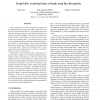780 search results - page 107 / 156 » Learning Mid-Level Features For Recognition |
INFFUS
2008
13 years 7 months ago
2008
act 11 We describe an ensemble approach to learning from arbitrarily partitioned data. The partitioning comes from the distributed process12 ing requirements of a large scale simul...
ICPR
2004
IEEE
14 years 8 months ago
2004
IEEE
lass Recognition using Images of Abstract Regions Yi Li, Jeff A. Bilmes, and Linda G. Shapiro Department of Computer Science and Engineering Department of Electrical Engineering Un...
BMCBI
2006
13 years 7 months ago
2006
Background: The rapid proliferation of biomedical text makes it increasingly difficult for researchers to identify, synthesize, and utilize developed knowledge in their fields of ...
ICCV
2007
IEEE
14 years 9 months ago
2007
IEEE
Topic models have recently emerged as powerful tools for modeling topical trends in documents. Often the resulting topics are broad and generic, associating large groups of people...
ISVC
2007
Springer
14 years 1 months ago
2007
Springer
We present a novel boosting algorithm where temporal consistency is addressed in a short-term way. Although temporal correlation of observed data may be an important cue for classi...

